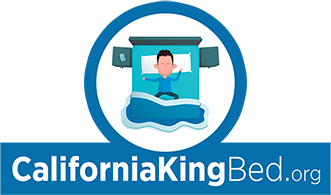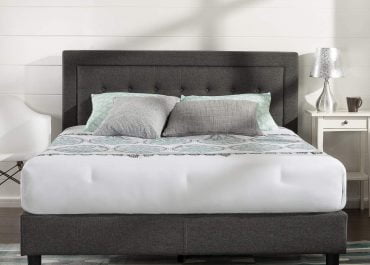Is Sleeping On The Floor Good For You?
While most people in Western countries are used to sleeping on big soft beds, there are many countries where people prefer to sleep on the floor. This might sound a little odd to you, but sleeping on the floor can be good for your back.
Sleeping on a mattress is indeed the most comfortable sleeping environment you can have. But there is an increasing number of people who would say otherwise.
In many countries, especially Asia people prefer to sleep on the floor. They find it more comfortable and beneficial for their body.
It is said that sleeping on the floor can minimize your back pain and also improve your blood circulation.
There are two ways to sleep on the floor: sleeping on the floor on a mattress or directly on the floor. While floor sleeping on a mattress is more supportive and comfortable, sleeping directly on the ground feels hard and firmer. Also, it feels less comfortable for many.
Now the question is “is sleeping on the floor good for you?” This is the question we are aiming to answer in this post. To know more about this, you should give this article a read.
Is sleeping on the floor good for your back pain?
“Is sleeping on the floor good for your back?” This is the most common question asked by people. Let’s answer it once and for all.
There isn’t any research or scientific proof available that proves sleeping on the floor is good for your back. Yet many people claim that it provides temporary relief from their back pain.
The thing about mattresses is that they are not very firm. In other words, they don’t provide you a lot of support. On the other hand, the floor is a hard surface that doesn’t let your body sink while sleeping. It prevents your spine to the curve which leads to back pain. This is why sleeping on floor is considered to be good. It is not only effective for your back pain but can also improve your sleeping posture to help you sleep better.
You will find plenty of research that suggests, a medium-firm mattress is good for comfortable sleeping. It can improve your sleep quality and also help in aligning your spine. According to a 2015 systematic review, all of this can minimize back pain.
Although there is no research available on sleeping on the floor, it is possible that the hard surface can have a similar effect on your back. However, it may not be suitable or good for everyone. Lack of cushioning around pressure points such as the tailbone, hips, back of the head, or shoulder blades could cause discomfort and also increase pressure. This can result in further pain and poor sleep quality.
The only proven benefits are linked to medium-firm surfaces. Instead of sleeping directly on the ground, you should use a medium-firm mattress. It is considered to be the best for improving sleep quality.
Types Of Floor Sleeping
As already mentioned above, there are two types of floor sleeping. You can either sleep on the floor directly or use a mattress to sleep on the floor. That being said, now let’s dig deep into the details.
-
Floor sleeping directly on the ground
Many people prefer to sleep directly on the ground. The floor is a hard surface that provides them complete support to their back. However, it is better to sleep atop a tatami or mat, instead of directly sleeping on the ground. You can even use a thin folding mattress, a mattress topper, or a sleeping bag when sleeping on the floor.
Sleeping directly on the floor is not encouraged due to various reasons. The first reason being hygiene issues.
If you are new to floor sleeping, you can create a layer of surfaces for extra cushioning and comfort. But at the same time, you will also get the support of the hard surface.
Floor sleeping on a mat or tatami is better than floor sleeping on a mattress. That’s because it provides pressure relief compared to a mattress.
-
Floor sleeping on a mattress
Many people prefer to lay their mattress on the floor and then sleep on it. You could say this is a more expensive way of sleeping on the floor. However, it is more plush and supportive.
When you sleep on the ground with a mattress, you are on a higher surface away from the dirt and dust on the floor. This option is more suitable for side sleepers, as they usually need more cushioning.
However, using a mattress on the floor can reduce the lifespan of your mattress. Not just that, but it also avoids many mattresses as many of the companies require you to place your mattress on specific foundations. Using your mattress on the floor makes it more vulnerable to bed bugs and wear and tear. Therefore, we don’t recommend you to use a mattress for floor sleeping. Instead, you should use a mat or tatami.
Benefits of Sleeping on the Floor
The idea of sleeping on the floor comes from the benefits it offers. It is not just budget-friendly, but it could also be beneficial to your health. In this section, we will be discussing the main benefits of sleeping on the floor.
- Minimize back pain
One of the most obvious benefits of sleeping on the ground is that helps reduce back pain. Although there is no research available that supports this idea, it seems to have positive effects on your back.
If you are someone who often wakes up with a backache in the morning, you should consider sleeping on the floor. It helps to align your spine and also provides full support to your back.
When sleeping on a mattress, your body tends to sink, which causes your spine to bend. But this can be prevented when you sleep on a hard surface. However, you should be using a mat, sleeping bag, or tatami when sleeping on the floor.
If you are a side sleeper, you should create a layer of materials to make it cushiony for you, or else it will cause further pain. As far as stomach and back sleepers are concerned, they reap the most benefits.
- Increases blood circulation
When sleeping on the floor, your weight is distributed evenly. This means, there are less pressure on your hips, lumbar spine, and shoulders. As a result, your blood can flow evenly throughout your body.
Healthy blood circulation is extremely important for your body. It helps you to perform basic physical functions. Besides that, blood circulation is also needed to carry nutrients and oxygen throughout your body. It also boosts your immune system, improves muscle recovery, and allows your lung and heart to function properly.
- Improves posture
Another big benefit of sleeping on the floor is that it helps improve your posture. Since the floor is hard, it keeps your spine straight and this ultimately helps to improve your posture.
Having a good posture means reduced risk of headaches, scoliosis, migraines, neck pain, joint pain, and shoulder tension. Not just that, but it also increases the capacity of your lungs and boosts your energy levels. In short, good posture can improve your overall mood.
- Affordability
Sleeping on the floor is an affordable option. If you prefer to sleep on the ground, you don’t have to spend huge sums of money to get a big, comfortable bed frame or mattress.
By ditching beds and mattresses, you can save thousands of dollars. To sleep comfortably on the floor, all you need is a mat, blanket, and pillows.
- Space-saving
By sleeping on the floor, you can also save a lot of space in your house. For floor sleepers, they don’t need a bed, which helps you to save floor space. This option is great for people who live in small apartments.
All you have to do is lay your mat on the floor and sleep on it. When you get up in the morning, you can fold and store your mattress away. By doing so, you can save a lot of floor space for your room.
Disadvantages of Sleeping on the Floor
Despite all the benefits, sleeping on the floor does have certain drawbacks as well. In this section, we will highlight all the disadvantages of sleeping on the floor.
- It is uncomfortable
Let’s be frank, sleeping on the floor is not for everyone. The floor is hard and feels uncomfortable. If you sleep on the ground in the wrong posture, it can cause you further pain.
While it may benefit your back pain, it causes soreness in the lumbar spine, hips, and shoulders, for others. Not just that, but it also triggers pressure build-up in many parts of your body. Also, it is not suitable for side sleepers as they need a softer surface to sleep.
- Risk of bugs and insects
Sleeping on the floor can be risky for a lot of reasons. For example, bed bugs, spiders, and ants can have easy access to you when you are asleep.
This is why you are recommended to protect your sleeping area by keeping your pillows and blanket off the floor during the day. Also, you should be using plywood or cardboard beneath the mat to raise it from the surface.
- Mold and mildew build-up
When you sleep on the floor with a mattress, it restricts adequate airflow beneath the foundation. In other words, your mattress traps sweat and heat, which eventually turns into a hotspot for mildew and mold.
Mold and mildew can cause unhygienic situations, which can ultimately trigger allergies. Also, it is not good for your mattress as it reduces its life span.
- Allergies
If you are allergic, sleeping on the floor is not a good option for you. The floor collects dust, dirt, skin cells, and many other particles. All this can trigger allergic reactions, especially if you are prone to allergies.
Besides, allergies can also cause other respiratory issues. This is why we don’t recommend allergic or asthmatic people to sleep on the floor. Allergy sufferers sleeping on the ground can experience itchy eyes, runny nose, coughing, and trouble breathing.
- Cold Floors
On a hot summer night, you can feel comfortable sleeping on a cold floor. But doing the same for one year can put you at a higher risk of catching a cold.
Also, sleeping on the floor during the winter is not recommended. During the winter times, the floor remains icy cold. Sleeping on such a cold surface is not at all good for your health. Even during rainy seasons, you can find it uncomfortable to sleep on the floor because of all the dampness. During the summer months, you can consider sleeping on a low bed frame.
How to sleep on the floor?
If you are used to sleeping in bed, it will be difficult for you to switch to sleeping on the floor. However, if you are determined to give it a try to ease your back pain, we can help you with it. In this section, we will explain to you how to sleep on the floor.
-
Preparation
The first step to sleeping on the floor is to prepare yourself mentally. Sleeping on the floor for the first few nights will probably feel a little uncomfortable. But you should be fine as you get used to it.
In the beginning, your body may pain a little as it adapts to the new changes. If you are overweight or are already suffering from some aches, you may need more time than others to adjust.
-
Choosing the right surface
The next step is to choose the right surface to sleep on. Just because you are sleeping on the floor, doesn’t mean you have to sleep directly on the ground. To make it a little more comfortable, you can use a mat, sleeping bag, or tatami.
With the help of these items, you can create a comfortable and firm surface to sleep on. By doing so, you can both reap the benefits of sleeping on the floor and not feel uncomfortable.
-
To Pillow or Not To Pillow
Many people sleep on the floor without a pillow. But you don’t have to make things so hard for yourself. Since the ground is hard, it can hurt the back of your head. This is why we recommend you use a pillow when sleeping on the floor.
However, some researchers suggest using a pillow to sleep on the floor isn’t that necessary. You can use your arm to elevate your head. But if you find that to be uncomfortable, you can use a thin pillow to support your neck and head. It is not advisable to sleep with more than one pillow as it may cause misalignment.
Types Of Surfaces To Choose From
When it comes to sleeping on the floor, you can choose from a variety of surfaces to sleep on. Instead of sleeping directly on the ground, you can use a barrier between your body and the floor.
The key to sleep on the floor is not to use something too soft. For instance a mattress. The surface you choose should be firm and provide full support to your back.
Here are some of the best options, you can choose from:
-
Tatami
With the help of a tatami, you can create the ideal surface to sleep on the floor. This is not a new item. Rather it is been used for years. This type of mat is highly popular in Japan. They have been using it for over 1200 years.
Tatami is available in different sizes. They are just a few inches thick and serves as the sleeping surface on the floor. Traditional Japanese people use tatami as flooring so that they can walk around barefoot comfortably.
Tatami is made with a rice straw core that comes with a soft rush straw covering. However, modern tatami includes polystyrene foam or wood chipboards as a core.
-
Yoga Mat
You can also use a yoga mat. It is similar to a tatami. These mats are soft and provide a comfortable and firm surface to sleep on.
The best thing about yoga mats is that they are damn cheap. You can get multiple yoga mats at once and use them alternatively. This simple thing can make sleeping on the floor much more comfortable.
-
Massage mat
Another great alternative would be a massage mat. These mats are available in all sizes and shapes. They are thin enough to let you reap the benefits of sleeping on the floor.
If you want a more traditional option, you can go for a Thai massage mat, which is softer than other massage mats.
FAQs
Final Words
Is sleeping on the floor bad? No, it’s not, provided you follow all the rules correctly. The best way to sleep on the floor is with some sort of a mat. This allows you to sleep comfortably while allowing you to reap the benefits of sleeping on a firm surface. However, you shouldn’t make sleeping on the floor a habit as it can make you vulnerable to cold and flu.

Fan of good quality sleeping and WordPress platform 🙂 Shopping is also my passion, that is why this article was created especially for you. Find out how you can sleep like a king and not overpay.







